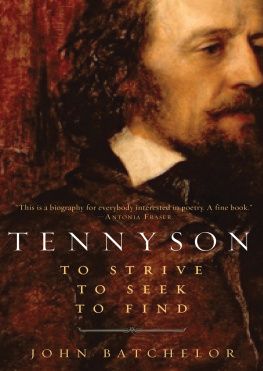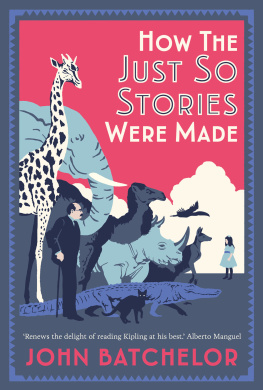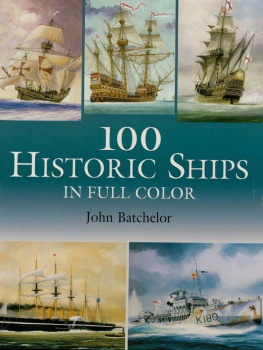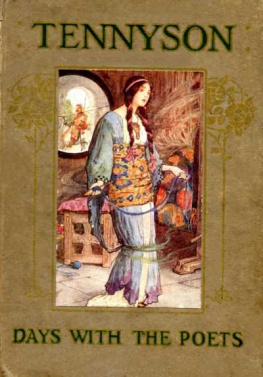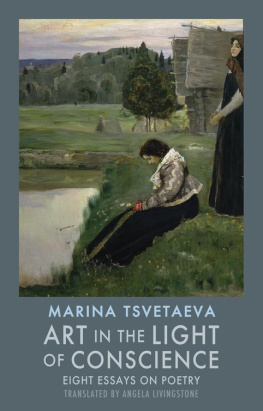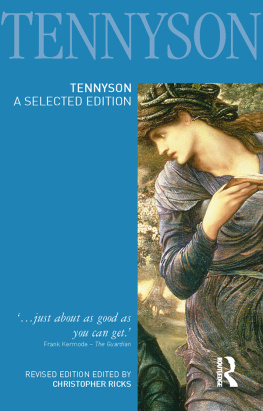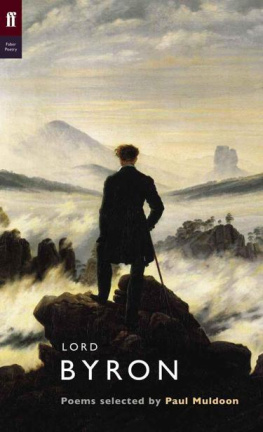TENNYSON
TO STRIVE | TO SEEK | TO FIND
J OHN B ATCHELOR

PEGASUS BOOKS
NEW YORK LONDON
Contents
List of Illustrations
Plate Section 1
Plate Section 2
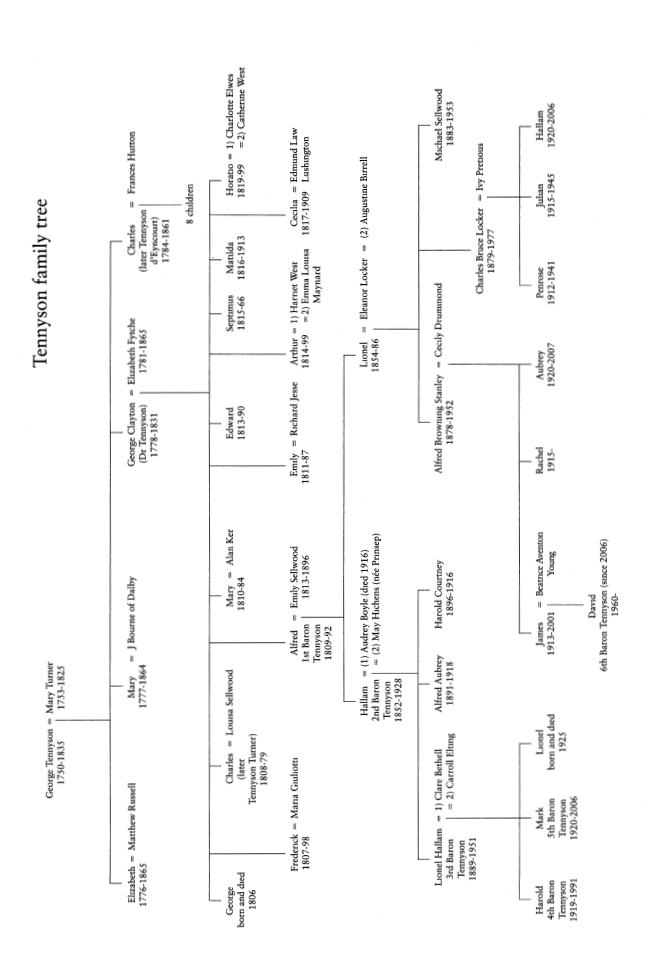
that which we are, we are;
One equal temper of heroic hearts,
Made weak by time and fate, but strong in will
To strive, to seek, to find, and not to yield.
For Henrietta, with love
Preface
This biography presents an Alfred Tennyson who is stronger, more self-reliant, more businesslike, tougher and more centrally Victorian than previous biographies have displayed. Like many successful Victorians, he was a provincial determined to make good in the capital while retaining his provincial strengths; in his particular case he never lost his Lincolnshire accent and in his relationships he remained close to his Lincolnshire roots. As the major poet of the age he determined the literary taste of the mid- to late-Victorian period; and then, strategically and with a secure instinct for the market, he fed that taste. The ascendancy of Tennyson was neither the irresistible triumph of pure genius nor an accident of history; he skilfully crafted his own career and his relationship with his audience.
Tennyson was Queen Victorias Laureate, and this book begins and ends with his direct contacts with her. He first came to know the Queen personally at an audience at Osborne House on the Isle of Wight in 1862, 150 years before the publication of this present biography.
Since 1980, when Robert Bernard Martin published Tennyson: The Unquiet Heart, the work of editors and archive scholars has made available a good deal of new information.
Tennyson at Aldworth: The Diary of James Henry Mangles, edited by Earl A. Knies (1984), reveals in the diary of a non-literary friend aspects of the poets personality hitherto unsuspected; the diary of George Stovin Venables, which provides much of the material in A Circle of Friends: The Tennysons and the Lushingtons of Park House, edited by John O. Waller (1986), is a similarly fruitful source; the Kemble letters, a collection of correspondence among Tennysons Cambridge friends which is now in New Zealand, give new information about Tennysons Spanish adventure of 1830 (and provide the basis of an excellent recent article by Marion Shaw, 2009); important work on the Tennyson family papers, especially those of Tennysons father, George Clayton Tennyson, and his uncle, Charles Tennyson dEyncourt, is presented in Poems by Two Brothers: The Lives, Work and Influence of George Clayton Tennyson and Charles Tennyson dEyncourt, edited by Christopher Sturman and Valerie Purton (1993). Among the other sources that have become available are the complete and updated three-volume Longmans annotated edition of Tennysons Poems, edited by Christopher Ricks (1987); the Letters of Tennyson in three volumes edited by Cecil Lang and Edgar Shannon (1982, 1987, 1990); the Letters of Edward Fitzgerald in four volumes edited by Alfred McKinley Terhune and Annabelle Burdick Terhune (1980, the year in which Martins biography was published); the Letters of Arthur Henry Hallam, edited by Jack Kolb (1981); the new research published by the Tennyson Society in the annual Tennyson Research Bulletin and in the Tennyson Society monographs. Tennysons Camelot, a study of Idylls of the King and its medieval sources, by David Staines (1982), extended our understanding of Tennysons huge final work. Leone Ormonds Alfred Tennyson: A Literary Life (1993), together with her essays and short monographs on him, has brought out much that was hitherto unknown or misunderstood about Tennysons relationship with the fine arts. Ann Thwaites biography of Emily Tennyson (1996) gave a fresh perspective on the Tennyson marriage.
The story of Tennyson, then, is ready for a narrative which takes into account the material that has become available in the last thirty years. The major manuscript collections for this book have been at the Tennyson Research Centre, Lincoln; the Lincolnshire Archives in the Lincolnshire County Record Office; the Houghton Library, Harvard; Boston Public Library; the Beinecke Rare Book and Manuscript Library, Yale; Trinity College Library, Cambridge and Cambridge University Library; the Fitzwilliam Museum, Cambridge; the Bodleian Library, Oxford.
For anyone seeking to write such a biography there is the well-known difficulty that most of the correspondence between Tennyson and his wife Emily in the 1830s and 1840s was destroyed. In justice to Emily (and to their son Hallam) it needs to be remembered that when they burnt these piles of correspondence after Tennysons death, they were acting on what they saw as his wishes. Tennyson regarded the activity of biographers as offensive and intrusive, and he would certainly have approved the determination that Hallam Tennyson showed in the two-volume Memoir to present the poet as he and his immediate family wished him to be remembered. It was not until 1949 that Tennysons grandson, Charles, published a biography which acted as a corrective to Hallams partial portrait.
I am grateful to David, Lord Tennyson, for permission to quote from Tennysons unpublished manuscripts; to Grace Timmins, librarian and archivist of the Tennyson Research Centre at Lincoln, for invaluable and constant help with the sources and the images for this book; to the Tennyson Research Centre and Trinity College, Cambridge, for permission to use images belonging to their collections; to the Beinecke Rare Book and Manuscript Library, Yale, for access to their Tennyson collection and for permission to quote from the Prinsep papers; to the Houghton Library, Harvard, Boston Public Library, Cambridge University Library, the library of the Fitzwilliam Museum, Cambridge, and the Wren Library of Trinity College, Cambridge, for access to their Tennyson collections; to Newcastle University Library, the Literary & Philosophical Society, Newcastle, Durham University Library, and to the support staff of the Newcastle University School of English for their help with my ongoing writing and preparation of the typescript; and to the British Academy for funding which enabled me to visit British locations connected with Tennyson and, especially, the Tennyson archives at Harvard and Yale.
I also have particular debts to the following: Professor Leone Ormond and Professor J. R. (Dick) Watson, both of whom read my text with great care and made a number of helpful suggestions; Penelope Hoare at Chatto & Windus for the expertise and dedication with which she has undertaken major editorial work on my typescript, and to Parisa Ebrahimi for her invaluable work on the later stages of the editorial process; to Felicity Bryan, my agent, for her unfailing encouragement; and to my wife, Henrietta, for the love and patience with which she has supported me during the writing of this book.
John Batchelor, Newcastle, June 2012
Prologue: The Tennysons and the Queen, 18621863
Wordsworth died in May 1850. The Poet Laureateship was promptly offered by Prince Albert to the obvious senior poet in literary London, a banker who was also a distinguished man of letters and a celebrated host and man-about-town, Samuel Rogers. For many years Rogers had wished for this court appointment, but as he was now eighty-seven years old, he felt obliged to decline. Once he had withdrawn, a group of younger figures, including Alfred Tennyson, Leigh Hunt and Elizabeth Barrett Browning, were in the frame. Tennysons son, Hallam, wrote in his

